Discover How to Grow Inside: Your Ultimate Personal Growth Guide

Welcome to my ultimate personal growth guide on how to grow inside. Indoor cultivation offers a unique opportunity to not only grow cannabis plants, but to also cultivate personal growth and development. In this guide, we will explore the essential steps to creating a thriving indoor grow room environment, selecting the best seeds for optimal growth, providing the right nutrients and water, managing light cycles and flowering stages, controlling pests and diseases, harvesting and curing your cannabis, maximizing yield and quality, troubleshooting common issues, and exploring different strains and varieties.
Whether you are a seasoned grower or just starting out, this guide will provide you with the practical tips, techniques, and strategies you need to grow your personal growth and accomplish your goals.
Key Takeaways:
- Indoor cultivation offers an opportunity for personal growth and development.
- This guide covers essential steps for optimal indoor growth, including environment, seeds, nutrients, and more.
- You can maximize yield and quality with advanced techniques and strategies.
- Common issues can be addressed through troubleshooting.
- There are a vast array of cannabis strains and varieties to explore.
Setting Up Your Grow Room
Welcome to the most critical part of your cannabis cultivation journey – setting up your grow room. A grow room is essentially where all the magic happens, and creating a controlled environment is vital for your plants to grow efficiently.
One of the most important aspects of creating a grow room is proper lighting. Your plants need ample amounts of light to grow, but be mindful of the amount of light you provide. Too much light can be harmful to your plants, while too little can impede their growth.
Another crucial factor to consider is space. Ensure that your grow room has enough room for each plant to have ample space to grow without crowding. Additionally, controlling temperature and humidity plays a critical role in ensuring healthy growth.
Proper airflow is also essential for your plants to thrive as it helps to reduce the risk of pests and diseases. Installing fans and proper ventilation will ensure a constant flow of fresh air and maintain a healthy environment for your plants.
Take the time to get these factors right, and your plants will grow healthy and strong in no time!

“Remember, a well thought-out grow room setup is key to healthy plant growth.”
Choosing the Right Seeds for Indoor Growth
When it comes to indoor cultivation, selecting the right seeds is crucial to achieving optimal growth and the desired outcome. There are various plant types to choose from, including cannabis seeds, each with unique characteristics and properties.
Whether you’re a beginner or experienced grower, it’s essential to choose seeds that match your goals and preferences. Consider factors such as growth rate, yield, flavor, potency, and aroma when selecting your seeds.
There are a vast array of cannabis seeds available for indoor growth, from Sativa and Indica to hybrid strains, each with their own unique traits. Sativa strains are generally known for their uplifting and energetic effects, while Indica strains tend to have more relaxing and sedative properties. Hybrid strains combine the best of both worlds and offer a balance of both Sativa and Indica traits.
In addition to strain types, consider features such as feminized and autoflowering seeds. Feminized seeds are often preferred as they guarantee that all plants will be female, maximizing yield potential. Autoflowering seeds are ideal for those seeking a quick harvest, as they automatically switch from vegetative growth to flowering, regardless of light cycles.
Ultimately, the key to choosing the right seeds for indoor growth is to consider your specific preferences and goals. Research different seed types and strains, read reviews, and consult with experienced growers to make an informed decision.
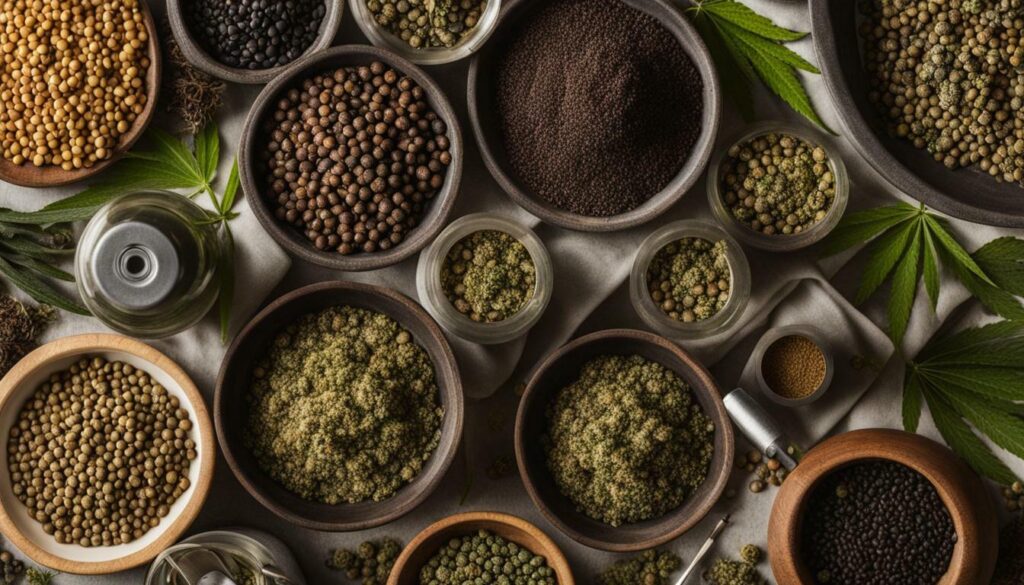
Providing the Right Nutrients and Water
One of the most critical aspects of indoor cannabis cultivation is providing the right nutrients and water to your plants. Unlike outdoor plants that can extract nutrients from the soil, indoor plants rely entirely on the nutrients and water that you provide them.
Water is the lifeblood of your cannabis plants, and it’s essential to give them the right amount at the right time. Overwatering can cause root rot, and underwatering can stress your plants and stunt their growth. As a general rule of thumb, water your plants when the top inch of soil feels dry. You can also check the weight of the pot; if it feels light, it’s time to water.
| Nutrients | Function | Examples |
|---|---|---|
| Nitrogen (N) | Stimulates vegetative growth and leaf development | Fish meal, blood meal, urea |
| Phosphorus (P) | Supports root development and flower formation | Bone meal, rock phosphate |
| Potassium (K) | Increases plant resilience and enhances flavor and aroma | Kelp meal, wood ash, granite dust |
Cannabis plants also need a balanced mix of macronutrients and micronutrients to stay healthy and produce high-quality buds. Macronutrients include nitrogen, phosphorus, and potassium, while micronutrients include calcium, magnesium, iron, and zinc.
You can provide nutrients to your plants in the form of organic or synthetic fertilizers. Organic fertilizers release nutrients slowly over time, while synthetic fertilizers provide an immediate boost. It’s crucial to choose the right type of fertilizer for your growing medium (soil or hydroponics) and growth stage (vegetative or flowering).
Remember, giving your plants too much or too little nutrients can cause nutrient burn or nutrient deficiencies, respectively. So it’s vital to follow the recommended dosage and schedule for your chosen fertilizer and monitor your plants’ response.

Providing the right nutrients and water is essential for optimal growth and bud development in your cannabis plants. By understanding the different types of nutrients and fertilizers and how to use them, you can help your plants thrive and produce high-quality yields.
Managing Light Cycles and Flowering Stage
Managing light cycles and the flowering stage are crucial steps in the indoor cultivation process, as they directly impact the yield and quality of your cannabis plants.
During the vegetative stage, cannabis plants require long periods of light, typically 18-24 hours per day, to grow strong and healthy. It is essential to provide the proper lighting, whether using LED, HPS, or fluorescent bulbs, to ensure optimal growth. Be sure to position the lights at the right distance and angle to provide adequate coverage without burning the plants.
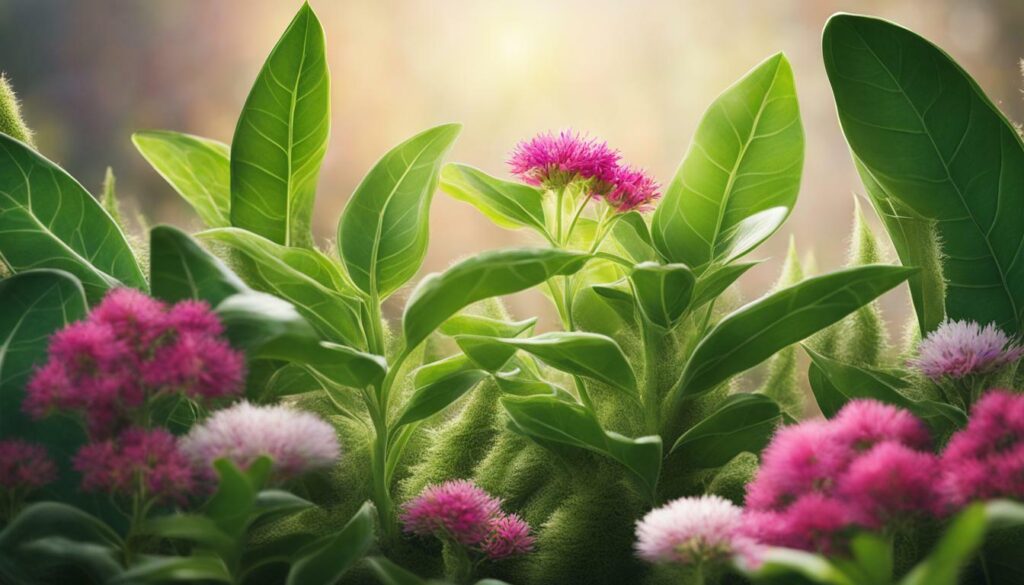
As you transition into the flowering stage, you will need to adjust the lighting schedule to simulate natural outdoor conditions. Most cultivators use a 12/12 light cycle, which means 12 hours of light and 12 hours of darkness. This change in lighting triggers the plants’ reproductive phase, where they will begin to produce flowers or buds.
Proper temperature and humidity control is critical during the flowering stage, as it can affect the potency and flavor of your final product. Lowering the temperature by a few degrees during the night can help improve resin production and enhance the aroma of your cannabis plants.
It is essential to closely monitor your cannabis plants during the flowering stage for signs of stress or nutrient deficiencies. Adjust the lighting, nutrients, and environmental conditions as needed to ensure your plants reach their full potential.
Controlling Pests and Diseases
I admit it’s not fun to talk about pests and diseases, but they are an unfortunate reality of indoor cultivation. Insects like spider mites, thrips, and whiteflies can wreak havoc on your cannabis plants, while fungal diseases like powdery mildew and bud rot can quickly spread and destroy entire crops.
Prevention is key, so it’s essential to maintain a clean and hygienic grow room. Regularly disinfect all surfaces and tools to prevent the spread of pathogens, and avoid introducing new plants from outside sources without thoroughly inspecting them first.
If you do notice signs of pests or disease, act quickly to prevent the problem from worsening. There are several natural and chemical treatments available, such as neem oil, insecticidal soaps, and fungicides. However, always read and follow the instructions carefully to avoid damaging your plants or compromising their health.
| Disease | Symptoms |
|---|---|
| Powdery mildew | White, powdery spots on leaves and buds |
| Bud rot | Brown or black spots on buds, followed by a foul odor and rotting |
It’s also important to regularly inspect your plants for signs of stress or nutrient deficiencies, as weak and unhealthy plants are more susceptible to pests and disease. Keep a close eye on your plants’ overall health and vitality, and make adjustments to their growing conditions as needed.
Remember, a proactive approach is always the best when it comes to pests and disease. By staying vigilant and taking the necessary precautions, you can minimize the risk and ensure a healthy, thriving crop.
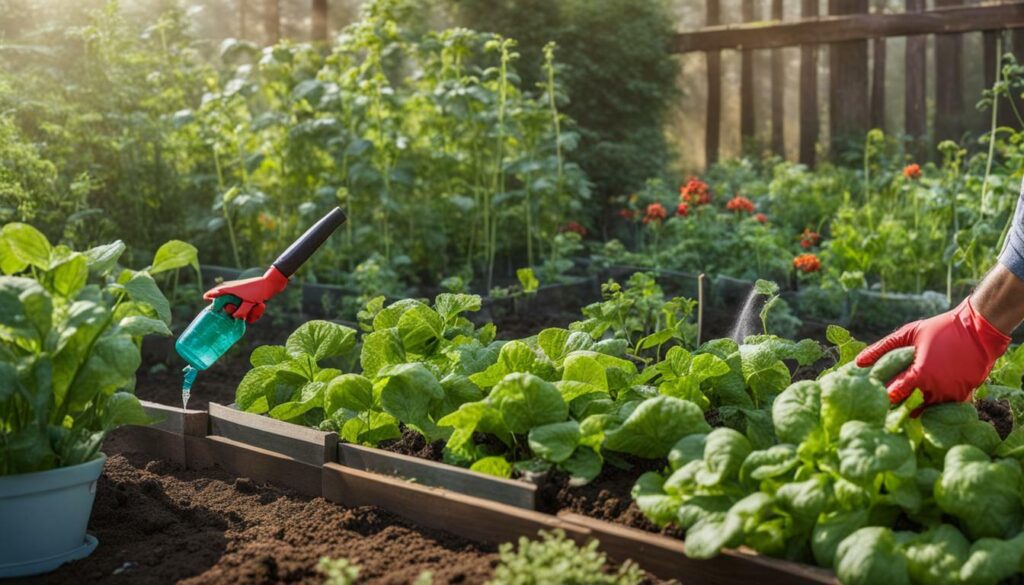
After weeks of carefully nurturing your cannabis plants, it’s time to harvest and cure them. This process is critical for preserving the quality, potency, and flavor of your crop.
First, you need to determine the optimal time for harvesting. This typically occurs when the plant’s pistils start to darken, and the trichomes (the tiny resin glands on the flowers) turn cloudy or amber. Use a magnifying glass or microscope to check the trichomes’ color and wait until at least 50% of them are cloudy or amber before harvesting.
Once you’ve harvested your plants, it’s time to trim the leaves and remove any excess stems. Then, you need to dry them in a dark, well-ventilated area for at least a week. Be sure to hang the plants upside down to allow for proper airflow and prevent mold growth.
After drying, it’s time to cure the buds. This involves storing them in airtight containers (such as glass jars) for several weeks, opening them periodically to release any excess moisture. This process allows the buds to develop their full flavor and aroma.
Remember that proper harvesting and curing are essential for maximizing the quality of your cannabis. Skipping or rushing this process can result in a subpar crop.
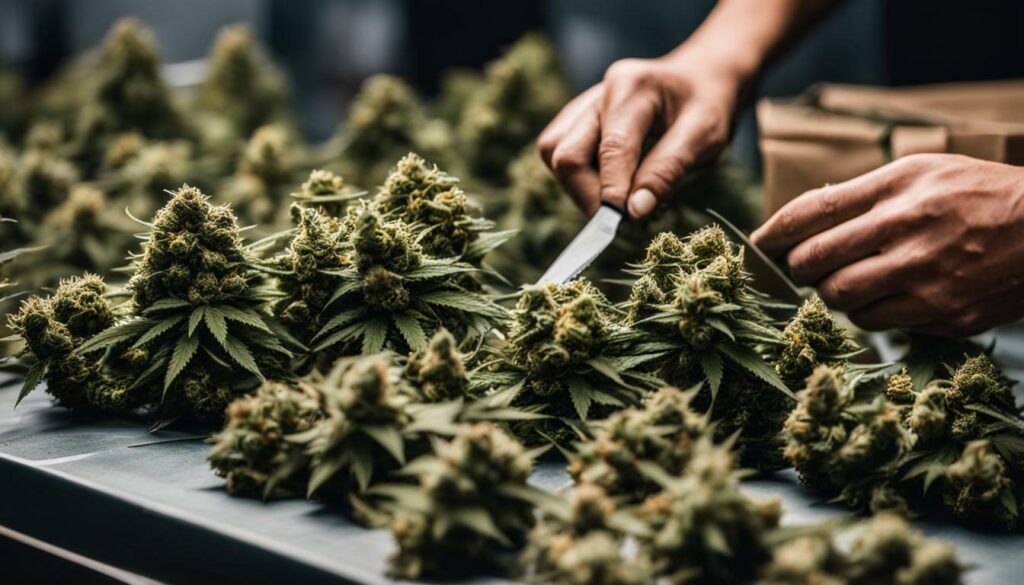
As an indoor grower, my ultimate goal is to produce the highest quality and yield of cannabis possible. To achieve this, I have implemented various techniques and strategies, which I will share with you in this section.
Prune and train your plants: Regular pruning and training can help promote even canopy growth and increase bud production. Removing any low-quality or damaged branches will redirect the plant’s energy towards the healthier parts of the plant. Additionally, training your plants to grow horizontally will increase the surface area exposed to light, resulting in more buds and higher yields.
| Techniques for Maximizing Yield and Quality: | |
|---|---|
| Low-Stress Training: This involves bending and training the plant’s branches to grow horizontally while avoiding any damage to the plant. | 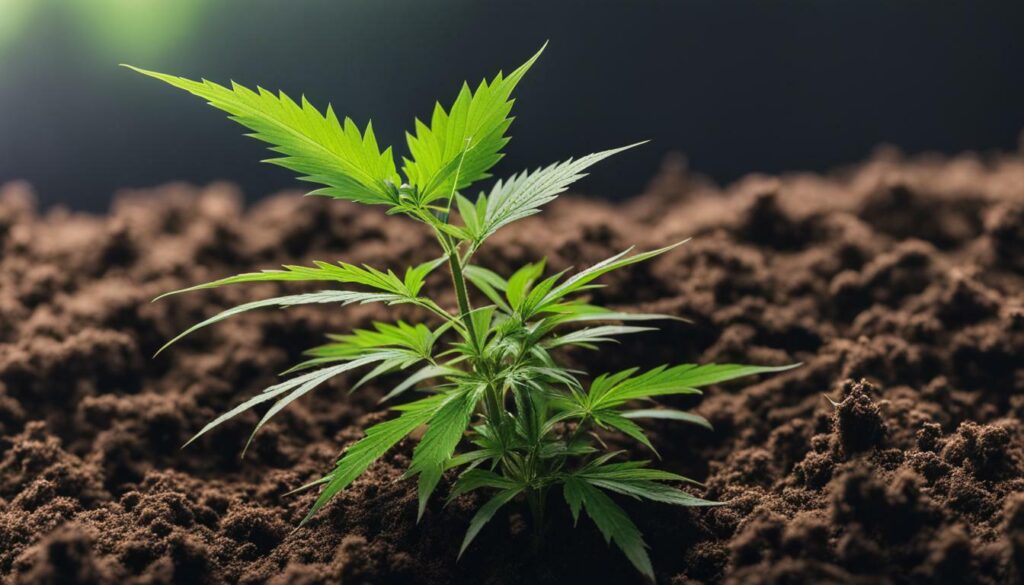 |
| High-Stress Training: This involves topping, fimming, or super cropping the plant to induce branching and increase yield. | 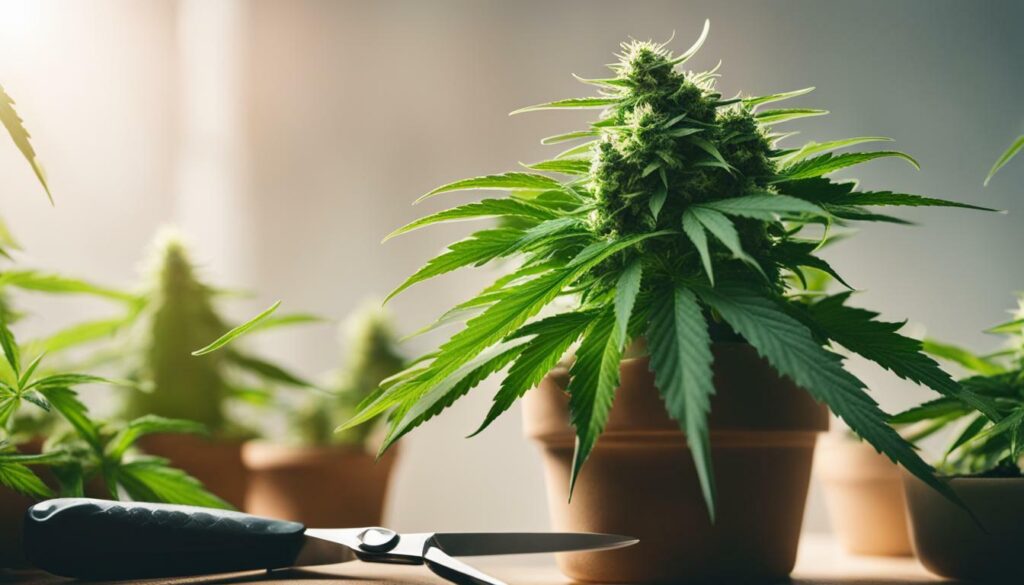 |
Optimize growth conditions: Providing the ideal temperature, humidity, and airflow can have a significant impact on your yield and the overall quality of your cannabis. Make sure to monitor and adjust these factors regularly for optimal growth.
Harvest at the right time: Harvesting your cannabis at the right time is crucial for preserving the potency and flavor of your buds. It’s important to wait until the trichomes are fully developed, which can be determined by examining them with a magnifying glass and checking their color. Additionally, flushing your plants with water before harvesting can help remove any excess nutrients, resulting in a cleaner and smoother smoking experience.
Cure your buds: Properly curing your buds can significantly improve their flavor, potency, and overall quality. This involves drying your buds slowly in a controlled environment, such as a curing jar, and regularly checking the humidity levels to ensure they remain between 60-65%. This process can take up to a few weeks, but the results are well worth it.
By implementing these techniques and strategies, you can significantly increase the yield and quality of your indoor-grown cannabis. Remember to always monitor and adjust your growth conditions and stay patient throughout the process.
Troubleshooting Common Issues
If you’re encountering problems with your cannabis plants, don’t worry! Many common issues can be easily resolved with the proper knowledge and techniques. One common problem is nutrient deficiencies, which can manifest as discoloration, stunted growth, or other symptoms. To troubleshoot this issue, consult a guide on nutrient requirements for cannabis plants or ask for advice from experienced growers.
Pests can also be a major problem for indoor cannabis cultivation. Common pests include spider mites, thrips, and aphids, which can be controlled through a combination of manual removal, natural predators, and insecticides. Diseases such as powdery mildew and root rot can also be carefully managed with proper hygiene and environmental controls.
Environmental factors such as temperature, humidity, and light cycles can also play a significant role in plant health and growth. If you notice any unusual symptoms in your plants, such as wilting, drooping, or yellowing, consider adjusting these factors and monitoring the plants closely. Finally, be sure to maintain a clean and sterile environment to prevent the spread of pathogens and ensure optimal plant health.
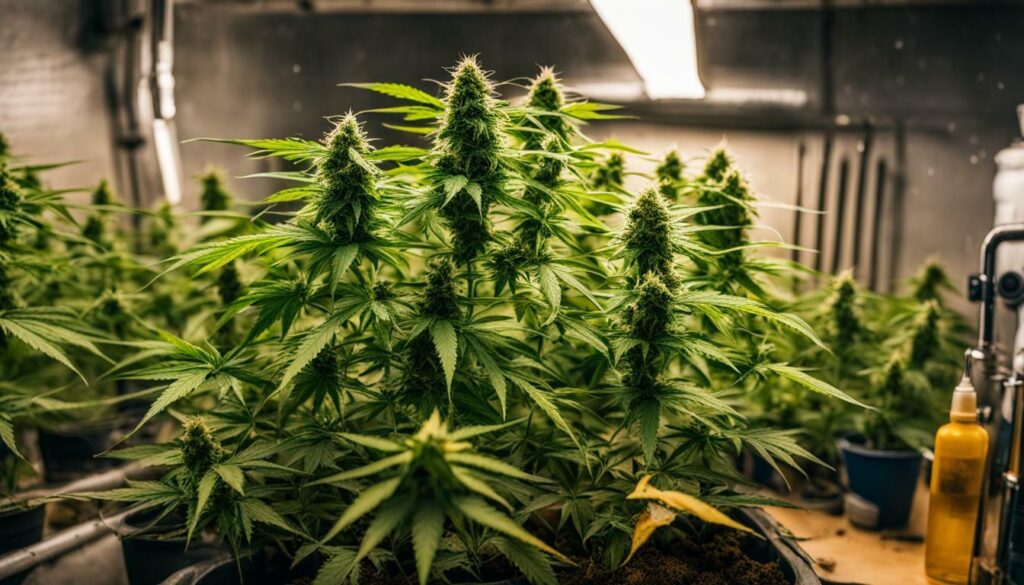
By remaining vigilant and proactive, you can troubleshoot and resolve common issues in your indoor cannabis grow room. Remember that experimentation and adaptation are key components of successful cultivation, so don’t be afraid to try new techniques and seek advice from experienced growers.
Exploring Different Strains and Varieties
Choosing the right strain or variety of cannabis seeds is crucial when it comes to indoor cultivation. With so many options, it can be challenging to know where to start. Here are some tips to help you explore and select the best strains for your needs:
- Consider your goals: Are you looking for a strain that will help you relax and unwind, or are you seeking one that will boost your creativity and productivity? Understanding your desired effects can help you narrow down your options.
- Research: Do some background research on different strains and varieties to find ones that are known for their potency, flavor, or other desirable qualities. Look for reviews from other indoor cultivators to get an idea of how a particular strain performs indoors.
- Experiment: Don’t be afraid to try out different strains and varieties to see which ones work best for you. Keep detailed notes on each plant’s growth and performance to help you refine your choices in the future.
Some popular strains for indoor cultivation include:
| Strain | Flavor/Effects |
|---|---|
| Blue Dream | Sweet, fruity flavor; calming yet uplifting effects |
| Sour Diesel | Skunky, diesel-like flavor; energizing, euphoric effects |
| Gorilla Glue | Earthy, piney flavor; relaxing, sedative effects |
Remember, the right strain or variety of cannabis seeds can make all the difference in your indoor cultivation journey. Take the time to explore and experiment with different options to find the ones that work best for you.
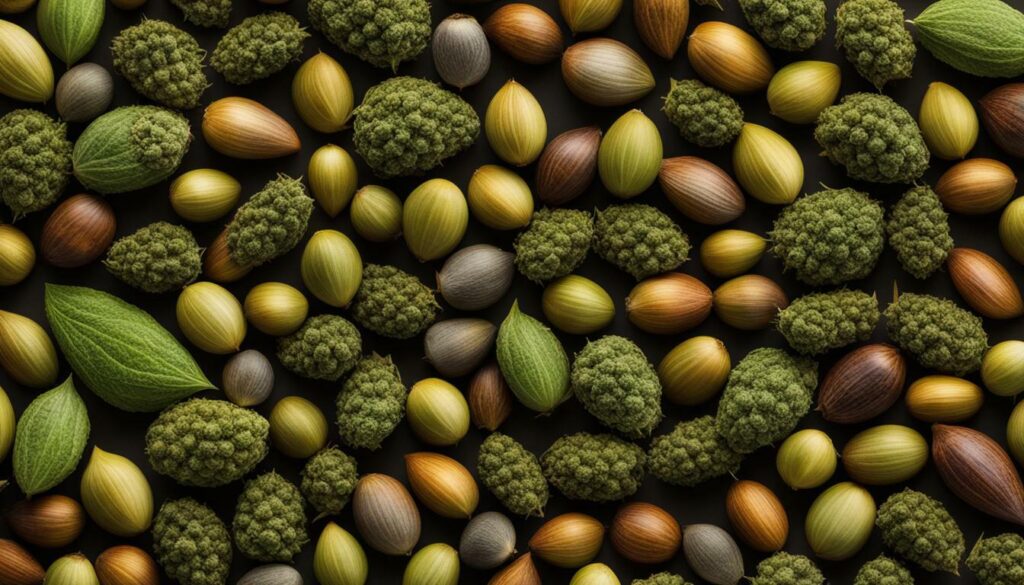
Indoor cultivation of cannabis plants offers an exciting opportunity for personal growth and development. Whether you are a seasoned gardener or a beginner, the principles of personal growth are universal.
By following the tips and techniques outlined in this ultimate personal growth guide, you will be well on your way to achieving your goals. From setting up your grow room environment, choosing the right seeds, and managing light cycles, to controlling pests and diseases, harvesting and curing your cannabis plants, and troubleshooting common issues, you can master the art of indoor cultivation.
Through this process, you will also be developing key personal growth skills such as patience, attention to detail, problem-solving, and resilience. These skills are transferable to other areas of your life, helping you to grow and develop as a person.
Remember, personal growth is a continuous journey, and indoor cultivation is a powerful tool you can use to enhance that journey. By staying curious, open-minded, and committed, you can unlock your full potential and achieve your goals. Thank you for joining me on this journey.
FAQ
Q: What is personal growth?
A: Personal growth refers to the process of self-improvement, self-discovery, and personal development. It involves taking intentional steps to improve one’s skills, knowledge, and mindset in order to achieve personal and professional goals.
Q: How can this guide help me grow inside?
A: This guide provides comprehensive information and practical tips for indoor cultivation, helping you learn how to create an optimal grow room environment, choose the right seeds, provide the necessary nutrients and water, manage light cycles, control pests and diseases, harvest and cure your cannabis, maximize yield and quality, troubleshoot common issues, and explore different strains and varieties.
Q: What is a grow room?
A: A grow room is a dedicated space or area specifically designed for the cultivation of plants indoors. It is equipped with the necessary equipment, such as lighting, ventilation, and temperature and humidity control systems, to create an ideal environment for plant growth.
Q: How do I set up a grow room?
A: Setting up a grow room involves several essential steps, including selecting the right space, installing appropriate lighting fixtures, ensuring proper ventilation for airflow, maintaining optimum temperature and humidity levels, and implementing an effective odor control system if necessary. This guide will provide detailed instructions on each of these steps.
Q: How do I choose the right seeds for indoor growth?
A: When selecting seeds for indoor growth, consider factors such as plant type, desired effects, growth characteristics, and personal preferences. This guide will help you understand the different types of seeds available, such as cannabis seeds, and provide tips for making informed choices.
Q: What nutrients and water do cannabis plants need?
A: Cannabis plants require a balanced supply of nutrients, including macronutrients (nitrogen, phosphorus, potassium) and micronutrients (iron, calcium, magnesium, etc.), as well as adequate water for proper growth. This guide will explain the specific nutrient requirements and watering practices necessary to ensure healthy and vigorous plants.
Q: How do I manage light cycles for my cannabis plants?
A: Light cycles play a crucial role in cannabis growth, particularly during the flowering stage. This guide will provide guidance on setting up proper light schedules, including the duration of light and darkness, to optimize plant development and encourage flowering.
Q: How can I control pests and diseases in my grow room?
A: Pests and diseases can pose significant threats to indoor crops. This guide will outline effective methods for identifying, preventing, and controlling common pests and diseases that can affect cannabis plants, helping you maintain a healthy and pest-free growing environment.
Q: How do I harvest and cure my cannabis plants?
A: Harvesting and curing are critical steps in the cannabis cultivation process that have a direct impact on the final quality and potency of the end product. This guide will provide step-by-step instructions on when and how to harvest your plants, as well as techniques for proper curing to preserve flavor, potency, and overall quality.
Q: How can I maximize the yield and quality of my cannabis plants?
A: Achieving high yield and quality requires implementing various techniques, such as pruning, training, and optimizing growth conditions. This guide will share advanced strategies and tips to help you maximize the yield and quality of your cannabis plants, ultimately resulting in a more bountiful and potent harvest.
Q: What should I do if I encounter common issues during indoor cultivation?
A: Indoor cultivation can present challenges such as nutrient deficiencies, pests, and environmental factors that can impact plant health and growth. This guide will help you identify and troubleshoot these common issues, providing solutions and recommendations to overcome them.
Q: What are the different strains and varieties of cannabis?
A: Cannabis comes in a wide range of strains and varieties, each with its own unique characteristics, effects, and flavors. This guide will introduce you to the various strains and varieties available for indoor cultivation, helping you explore and select the ones that best align with your preferences and cultivation goals.